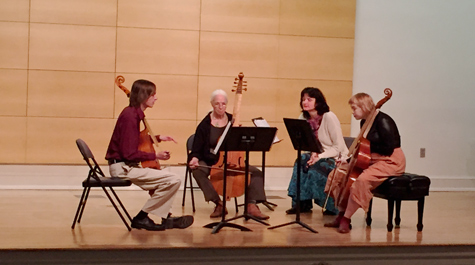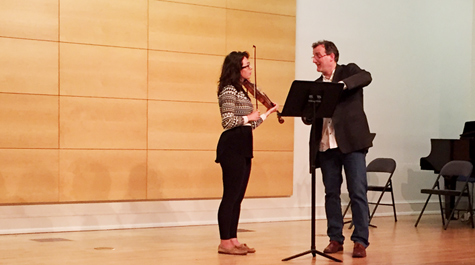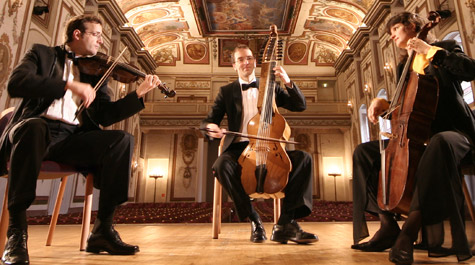Music students have rare chance to work with Esterházy Trio
Joseph Roth’s life got a little more dissonant after working with the Esterházy Trio.
Well, maybe not his life. But the senior viola da gamba student’s appreciation of dissonance in music intensified after spending more than a half-hour with the famed Viennese trio’s leader, Michael Brüssing, in a recent strings master class at William & Mary.
{{youtube:medium:left|k4jyOynvA0g}}
Master classes allow W&M music majors to spend time one-on-one working on technique and historical interpretation with visiting players, many of them among the best in the world.
“I was so pleased with the opportunity to work with the Esterházy Trio,” Roth said. “They’re fantastic people.”
Roth has participated in master classes before, but this one was rare. He is one of only two viola da gamba students on campus, he said, while the Esterházy Trio specializes in music for the rarely-heard baryton, an instrument similar to the viola da gamba, dating from the 17th century.
For the class, Roth chose to play Carl Friedrich Abel’s “Piece for Solo Viol in D Minor,” which he had performed in his senior recital.
“Immediately I knew it was going to be fabulous and that [Brüssing] was going to be a fantastic teacher,” Roth said. “Because of the way he spoke about the music and how familiar he was with all of the tone qualities and themes in the piece, he very obviously knew so much about the music and how it’s intended to be played. And he was very good at being able to express to me what I should change to be able to produce certain tones or how I should change if I want to get different sorts of expressions or different qualities in the music.”
The piece is marked by its dramatic opening, which Brüssing said should carry a “round” sound. At one point, he took the bow from Roth to demonstrate a method of moving the bow over the viol’s string in a great, sweeping arc.
“It was the opposite of how I’d been taught to play the instrument,” Roth said. “You’re taught to play the viola da gamba having the tip of the bow pointed downward relative to the bridge. This way he showed me to play the opening chord, it was opposite – to the extreme. The tip was pointed up directly at me. My teacher here, Sarah Glosson, commented in my next lesson that she had also never seen that before. It was a new thing to both of us.
“But it got the exact sound quality he wanted. It was interesting to see somebody go so far away from the standard, accepted technique to get such a beautiful sound that was so appropriate to the piece.”
Roth was one of five students who worked with the trio in the strings master class before it gave two performances in Williamsburg the next day. The April visit was part of the Esterházy Trio’s first tour of the United States, arranged by James Armstrong, music professor and director of choirs at W&M.
Armstrong and his spouse, Jamie Bartlett, chair of the music department and associate director of choirs, first met the trio in Austria in 2008.
“I have been particularly interested in bringing the trio to William & Mary because they represent in their playing a musical tradition of aristocratic music making that I have had the pleasure of studying in my research,” Armstrong explained.
In 2008, the Esterházy Trio had just released a 21-CD recording of the complete chamber works for baryton by Joseph Haydn. Haydn’s great patron was Nicolas I, Prince Esterházy, a skilled amateur baryton player in his own right.
Armstrong has been working since 1999 on a scholarly, electronic catalog of the Esterházy sacred music collection, comprising more than 3,000 pieces of sacred music used by the court in its worship services.
“Both Jamie and I were so taken by their beautiful performance – authentic from a historical perspective and the very best of European music making – and also with them as wonderful people that we have been trying since 2008 to make arrangements to bring them to the United States,” Armstrong said.
Originally scheduled to perform one concert in the Wren Building’s Great Hall, so many people showed up that the trio played a slightly abbreviated program twice to accommodate the crowds, taking only a 15-break between performances. Those who attended both concerts heard all the music the trio had originally planned to play plus encores. The trio’s visit was sponsored by the music department and the Ewell Concert Series as well as the dean of student affairs, the Reves Center for International Studies and German studies.
The trio also played at Lynchburg College and at the Hungarian Embassy in Washington, D.C., as part of the renowned Embassy Series.

















